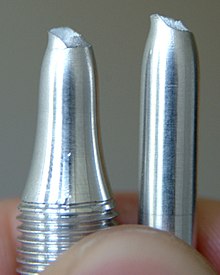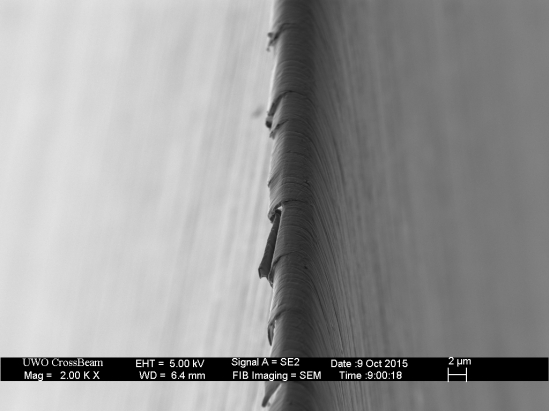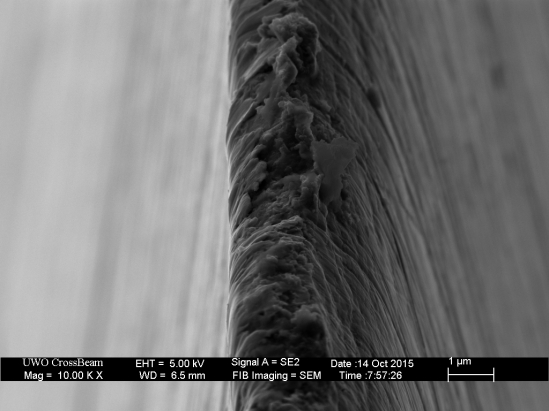- Joined
- Mar 8, 2008
- Messages
- 26,134
The entire topic of burr formation, burrless sharpening, burnishing mechanisms is tough to pin down.
In my experience, using a smooth steel on low RC cutlery improves edge retention. Nothing crazy, but there is an improvement. I liken this to the small anvils used to workharden the edge of certain unhardened/partially hardened agricultural cutting tools (Fortytwo blades can elaborate on this better than me). Yes, repeated steeling will lead to brittle failure or a drawn out edge at some point, but all edges dull anyway and whatever maintenance is needed after the initial cycle, it doesn't matter if you continue steeling or take it to a mug or stone - the edge became dull from use.
Part of an experiment I ran on higher RC sporting cutlery (58-60), coming off of the initial bevel setting I smooth steeled the edge with upwards of 3-4 lbs of pressure at the exact same working angle, using a 1/4" hardened rod. In some cases this drew out the edge a small amount, in many cases it didn't. The edge was then finished with either a microbevel or at the original angle with a finer stone. If the edge had experienced a pressure burr from the steeling, this was removed with the higher angle and edge re-established at the target angle.
These were compared against edges that did not have this pre-treatment. The hypothesis was twofold - either the edge will fail early due to subsurface plastic deformation, or it will last longer due to the effect of workhardening increasing tensile strength and hardness.
There was no appreciable difference between the four preparations.
I have likewise run tests using plateau sharpening vs edges crafted with a small burr. Again, there was no appreciable difference.
Theoretically, any workhardening from flipping the burr should actually be beneficial - increase tensile and hardness trade off for decrease in ductility. This is the exact strategy employed in many laminated steels, tho arrived at using different process - the cutting edge doesn't need to be ductile. Take a piece of 3/4" copper tubing and bend it 30-40°. Now bend it back. Repeat. You'll find it gets extremely tough, tougher than you might have imagined if you've never actually done this before. Which would you rather make a cutting tool from, the workhardened piece or the original highly ductile piece? I realize this is not the same as a knife edge, but then neither is the paperclip analogy.
Ultimately, I came to the conclusion that whatever effect this factor contributes, it is absolutely dwarfed by other contributors. Tracking this down would require a huge sample from many different participants. When one person is prepping and testing for all we know the only thing we've learned is that they're better at one form of edge finishing than another.
Something important to bear in mind when talking about work hardening is that it only increases resistance to dulling via plastic deformation, but doesn't increase wear resistance. Since this is a method most commonly used with European style scythes, it's worth noting my observations regarding blade hardness between European scythe blades, which have their edges peened to shape, vs American blades (which are hard, and have their edges ground to shape.) Euro blades, with rare exceptions (like Russian blades) are usually only about 45 RC and the edges then drawn out with a special hammer and anvil, which both provides a thin bevel and a work-hardened edge which helps that very low angle soft steel not simply buckle on itself in use. However, American blades tend to be more like 54-58 RC. Peening the edges (of Euro blades) has been lab tested in the past and it only raised the hardness by a couple points, while the actual composition of the steel remained the same--mostly pearlite. The hardness of the American blades is attained through heat treatment and is the result of the martensitic structure of the steel rather than disruptions of the crystal lattice like it is in work hardening. Martensite is much more wear resistant than pearlite, and so between the large hardness difference in general plus the wear resistance of the martensitic structure I get something like 5x the edge holding out of American blades. Even if you were to heat treat one blade to 47 RC and another to 45 RC but then work hardened it up to 47, you'd be getting better performance out of the one that was simply heat treated and left unhammered. The reason for using the soft steel in that case is because of structural factors with how they manufacture them that drastically reduces failure rates, and also happens to make the steel easier to hammer out in beveling...which is kind of a self-fulfilling prophecy of sorts.
In general it tends to be better to just use harder steel rather than imparting any deliberate work hardening, but sometimes ease of sharpening takes priority over other factors.







